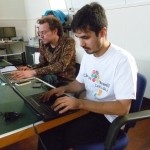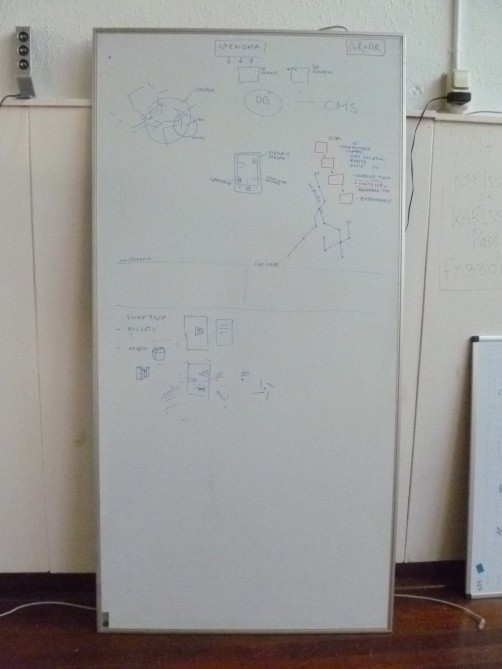19/03/2012
Interview 2
Julia Bac and Sander Veenhof (Amsterdam)
J: You have been working with Pixel for 3 weeks already. How are you working together?

S: I think we are bringing our own backgrounds into the project. In this specific case is very helpful, we sort of swapped each other’s fascinations.
We usually meet up here (at the Nimk) and we had some Skype moments, we also installed a sketch board upstairs. It’s a very technical drawing, cause in one of the first discussions we discovered that it goes much faster if you just talk about the technical stuff. You can start at the other end, but sometimes is good to know what is the actual thing that you are creating. You have to know what it should be like. And we started this process as well.

J: What you mean is that the technique limits what you can do?
S: No, not really. But is good to know where there are choices to make. Sometimes choices arise from the technique. Some things we had in mind and we already think ahead what would be the consequences, how you can develop a user experience. In the end you have to create this technical thing and it doesn’t appear out of nowhere.
J: Is this how you usually work?
S: Yeah, there is this initial idea. You sort of envision it. Start sketching the scope, what do you want to do, and then you continue thinking on how to optimize it, how to change it a little. You develop a concept that includes a technical part and you have to jump back and forth between technique and concept.
J: In which “stage” do you see the project at this point?
S: I think it is defined. We have the basis now, except the implementation. Now comes the interesting part, which is proving that what we are creating could have impact and could be relevant and interesting enough. That’s what we have to prove right now.
J: What do you mean with the “basis”?
S: It’s the scope. We have the scope right now, which is what we want to achieve with all the requirements and the starting point. We have now something that we both feel confident that could be the right way, that in the end we’ll get to something interesting.
J: Why you decided to have two different projects?
S: I think that also has to do with the two countries and our personal different backgrounds, we kind of swapped our fascinations. I came in with a lot of experience with GPS based projects and I was inspired by Pixel’s work using marker-based AR. For Pixel, it was the other way around.
And makes sense because the QR codes projects would be really helpful in Brazil. The two countries are very different, so it makes sense to make something that its appropriate instead of making one project that can be quite a struggle to be relevant here and there, because the situation is quite different.
J: What was the most significant change that the project had since you started?
S: The most significant change was to decide to work in two things. Because the two locations are very different, makes sense to put all the ideas into two separate projects.
In the beginning we thought that maybe we could develop only one, but I think that doing two is better.
I think that the major brake through is going to come this week. You could ask the same question on Friday, because I hope we are going to have major change.
Meeting Jan Rothuizen on Wednesday will be helpful. We will have to tell him what we are doing and see if, someone that hears our idea for the first time, would understand what we are aiming.
J: You also have been discussing your project with the Nimk staff and Annet Dekker (the organizer). What was the most significant feedback you had so far?
S: I think they were all stressing the same point. We are in search of something that is not there, that doesn’t exist. But, we both strongly believe in it and we talk about it, as it already exists. With their questions they really force us to make what we are doing more precise, and ask ourselves: what is the special added value? Now we have to get the right showcases that also help us to understand what we are actually talking about.
My personal idea is that by this process we are learning a new tool. Then, getting use to the new possibilities of the things we are creating, I would also be able to take a step where we can create something that we cannot foresee yet. That’s what I hope. Because if it’s very predictable, you can ask: should you make it?
J: How could you achieve this situation? Would it come by experimenting?
S: You first do the obvious things and then in the end you get to something that is a perfect conceptual piece, I hope. But, it’s hard to get there in one go. Sometimes, you have this idea, that is brilliant from the beginning on, but sometimes you just shape the conditions by exploring further and then suddenly it’s like a puzzle, that all parts connect.


